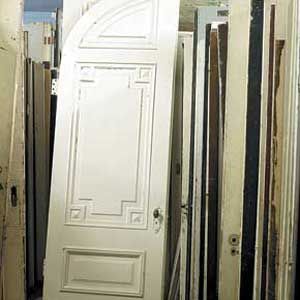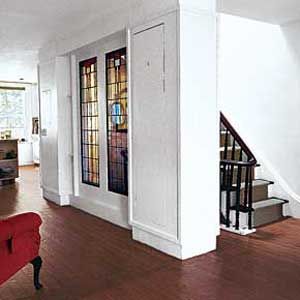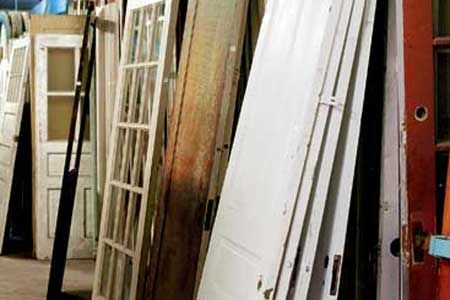Old doors have a unique charm that adds character and history to a home. This guide will walk you through fitting and repurposing old doors, from measuring and choosing the right style to creative upcycling ideas and installation tips.
Incorporating Vintage Doors
Vintage doors offer a certain craftsmanship and character often missing from modern mass-produced options. Unlike the plain wooden slabs or molded metal doors commonly found in home centers today, old doors typically feature raised wood panels, arched tops, or leaded glass insets that add visual interest and historical significance to a space.
These timeworn pieces are often made from old-growth wood, a resource that’s no longer readily available. This gives them a unique patina and durability that’s hard to replicate. Whether you’re restoring a period home or adding a touch of nostalgia to a modern space, incorporating vintage doors can dramatically enhance your home’s look and feel.
Measuring and Fitting Old Doors
Before falling in love with a salvaged door, determine whether it will fit your existing doorway. Old doors were often custom-made, so their dimensions may not be compatible with modern standard sizes. Follow these steps to measure an old door:
- Measure the distance from the inside of one side jamb to the other.
- Measure the distance from the threshold to the header.
- Subtract one-quarter of an inch from each measurement to account for proper clearance and door swing. This will give you the maximum dimensions for your old door.
Addressing Size Discrepancies
If you find a door you love that doesn’t quite fit, don’t despair. Instead, modify old doors to fit your space as follows:
- If the door is too large: You can trim up to an inch from the top, bottom, or sides without compromising the door’s integrity or proportions.
- If the door is too small: You may be able to add wood sections to enlarge the door. However, this is a more complex process that may require professional assistance, especially for stained doors where you need to match the wood and finish.
Choosing the Right Vintage Door for Your Space
Selecting the perfect vintage door involves more than just finding one that fits. Consider the following factors to ensure your chosen door complements your home:
Considering Door Finishes
Your vintage door’s finish can significantly impact its appearance and price. Decide whether you prefer the stained finish’s depth and character or want to customize it with paint. Remember that stained doors typically deepen in color with age, adding to their antique appeal.
Matching Door Styles to Home Architecture
Your door style should harmonize with your home’s architectural design. For example, the following home styles historically lend themselves to these associated door types:
- Colonial Revival homes: Six-panel interior doors
- Craftsman houses: Oak doors with leaded glass insets
- Cabins: 19th-century barn doors with wrought iron strap hinges

Creative Ways To Repurpose Old Doors
If you love the look of vintage doors but don’t have a suitable doorway, consider the following ideas to repurpose an old door:
- Kitchen decor: You can repurpose an old door as a decorative panel for a kitchen island facade.
- Unique furniture: You can reimagine old doors as unique furniture pieces. You can use all or part of an old door as a work surface, a bed headboard, window shutters, garden gates, a back for bench seating, or a hinged folding screen for dividing rooms.
- Wainscoting: When repurposing doors as wainscoting, create a uniform look using doors of the same style, height, and width. Finish vertical seams with wood trim and top the panels with a chair rail for a polished appearance.
- Wall art: You can turn beautiful vintage doors into wall art.

Restoring and Refinishing Vintage Doors
Bringing an old door back to life often involves some restoration work. Follow our step-by-step guide below to restore a vintage door.
Stripping and Repainting
Follow these steps to strip and repaint painted doors, especially those with peeling or lead-based paint:
- Use a chemical stripper or heat gun to remove old paint layers.
- Sand the surface smooth.
- Apply a primer suitable for the door material.
- Paint with a durable exterior or interior paint depending on where you intend to install the door.
Preserving Original Stains and Finishes
Follow these steps to preserve a stained door’s original finish if you already like how it looks:
- Gently clean the surface with a mild soap solution.
- Apply a clear protective finish to preserve the existing stain.
- Consult a professional who can match the wood and finish if you need to conduct any minor repairs.
Installing Salvaged Doors
Installing a vintage door can present unique challenges and require extra care. Consider the following factors before purchasing and installing an old door:
Adapting Doors to Modern Hardware
Old doors’ hardware configurations often differ from modern ones. Manufacturers typically used to cut old doors for mortise locks, while today they bore most new jambs for a cylinder lockset. You may need to adapt the door or the frame to accommodate modern hardware or source period-appropriate fixtures.
Handling Swing Direction and Hinge Placement
Before purchasing a vintage door, determine the required swing direction and hinge placement. You need to know whether you’ve got a left- or right-handed swing, which refers to where the hinges are located, not where the doorknob is. Ensure the door’s existing hinge mortises align with your frame or be prepared to create new ones.
Where To Find Vintage Doors
Local salvage yards are treasure troves for old doors. These businesses often have a wide selection and knowledgeable staff who can help you find the right fit for your project.
Online Resources for Antique Doors
If you can’t find what you’re looking for locally, try the following online options:
- Online marketplaces such as eBay or Etsy
- Social media platforms where individuals and businesses list salvaged items
- Specialty websites dedicated to architectural salvage

